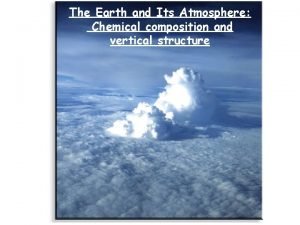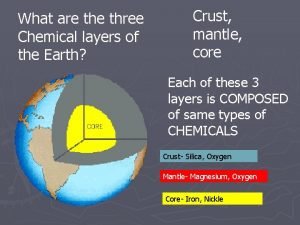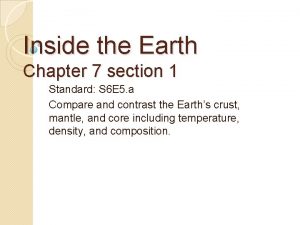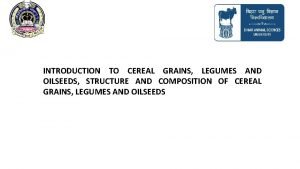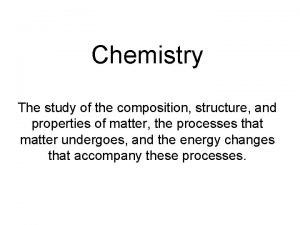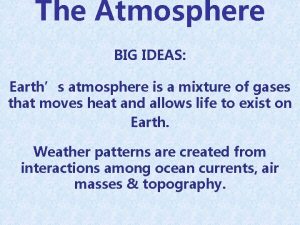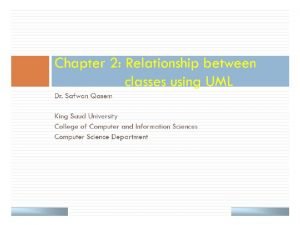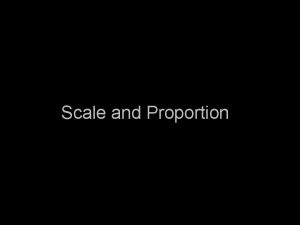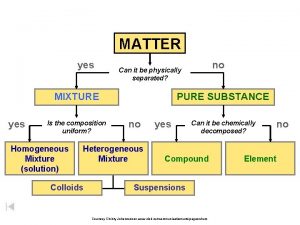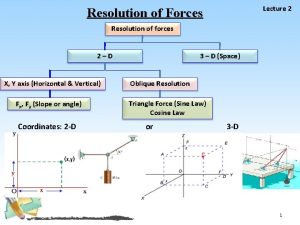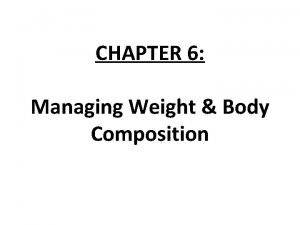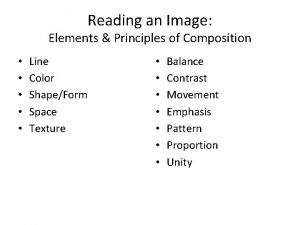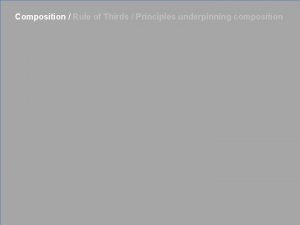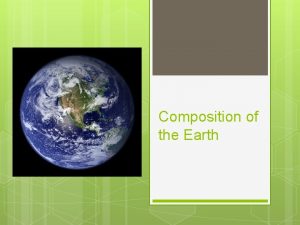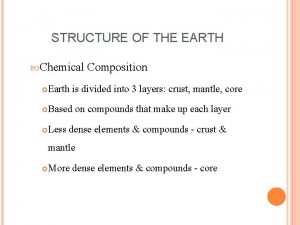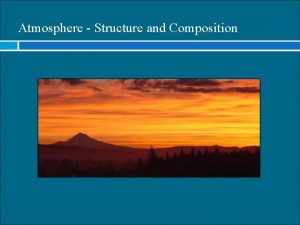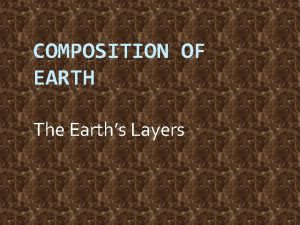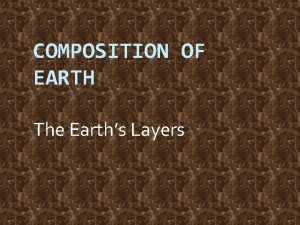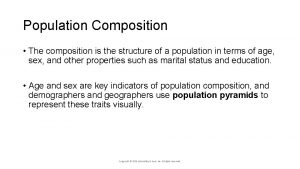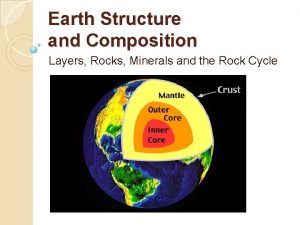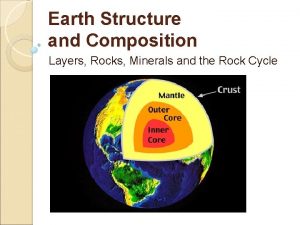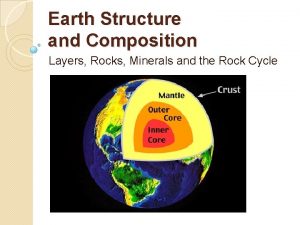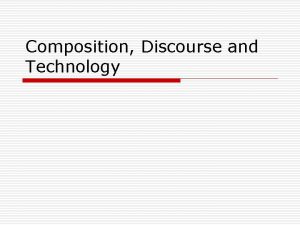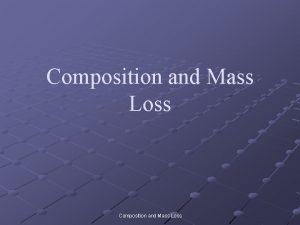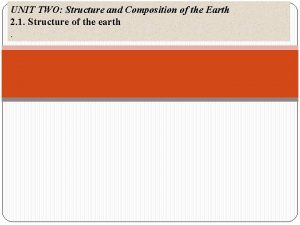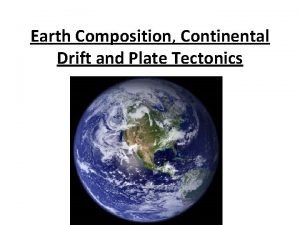EARTH STRUCTURE AND COMPOSITION Structure of Earth EARTH

























- Slides: 25

EARTH STRUCTURE AND COMPOSITION Structure of Earth

EARTH SIZE AND SHAPE • Earth is almost spherical, or ballshaped, however its shape is not perfect. • Earth is a little flattened at its poles and bulges a bit at its equator

EARTH PROFILE • Mass = 5, 882 sextillion metric tons • Volume = 1, 083 billion Km 3 • Total surface Area = 510 million km 2 • Land Area = 149 million Km 2 • Water Area = 361 million km 2

STRUCTURE OF EARTH • Earth is made of several materials, which make up different layers. • Earth has four different known layers. q. Crust q. Mantle q. Core ØOuter core ØInner core

THE CRUST • The Earth’s outermost layer • Earth’s crust is made up of: q. Soil q. Rocks ØSilicon and oxygen (primary elements) ØAluminum ØCalcium….

THE CRUST • Thickness: q 5 to 10 km beneath the oceans q 20 to 70 km beneath the continents

THE MANTLE • Thickness: About 2900 km • High temperatures (2800 to 3200 C)

OUTER CORE • Thickness: About 2250 km • Made up mostly of melted iron and nickel • Temperatures between 4000 to 5000 C

INNER CORE • Thickness: About 1280 km • Made up of solid iron and nickel • Temperature estimated at 6000 üNote: Although the inner core

OTHER RESOURCES • http: //www. youtube. com/watch? v =NAHY 6965 o 08 • http: //www. youtube. com/watch? v =Q 9 j 1 x. Gax. Yz. Y • http: //www. youtube. com/watch? v =3 MFr 2 c. C 3 erk

LATITUDE AND LONGITUDE • Mapmakers use a set of imaginary lines that cross each other to identify places on earth. q. Latitude q. Longitude

LATITUDE • Circle Earth in a east-west direction • The central line of latitude, the equator, divides Earth into the northern and southern hemispheres • It is the distance of a place north or south of the equator measured in degrees

LONGITUDE • Circle Earth in a north-south direction • It is the distance of a place east or west of the prime meridian • Prime meridian is the central line of longitude, which divides Earth into an eastern and western hemisphere

LATITUDE AND LONGITUDE

ROCKS • Rocks are solid Earth materials formed from a mixture of minerals and sometimes other materials. • They are classified into one of the three groups based on how they are formed

GROUPS OF ROCKS • The three groups of rocks are: q. Igneous rocks q. Sedimentary rocks q. Metamorphic rocks

IGNEOUS ROCKS • How are Igneous rocks formed? ØHigh temperatures deep in Earth’s crust cause rocks and minerals to melt, forming magma ØWhen magma reaches Earth’s surface it becomes lava • Igneous rocks form when magma or lava cools and become solid

IGNEOUS ROCKS q. Some Igneous rocks form from quickly cooled lava üThey are called extrusive or volcanic (such as rhyolite) q. Some igneous rocks form from slowly cooled lava üThey are called intrusive or plutonic ( such as granite)

SEDIMENTARY ROCKS • What is sediment? • Give some example of sediment üPieces of rocks üMinerals üRemains of living things üDissolved minerals that come

SEDIMENTARY ROCKS • Sedimentary rocks form when sediment becomes solid material • How are sedimentary rocks formed? üSediment is moved by wind and water and piles up on land riverbed, lake bottoms and the ocean floor. New layers of sediment build up over time

TYPES OF SEDIMENTARY ROCKS • There are three types of sedimentary rocks. q. Clastic sedimentary rocks q. Chemical sedimentary rocks q. Organic sedimentary rocks

CLASTIC SEDIMENTARY ROCKS • Sandstone • Shale • Many kinds of limestone

CHEMICAL SEDIMENTARY ROCKS • Rock salt üForms when minerals come out of solution and settle on the ocean floor.

ORGANIC SEDIMENTARY ROCKS • Chalk üForms from the remains of once-living things

METAMORPHIC ROCKS • Metamorphic rock is rock that has been changed in form by pressure and heat. üGneiss and slate • Over time, heat and pressure inside Earth squeeze and melt existing rocks. This process changes the grain size and even the minerals that make up those rocks.
 Structure of atmosphere diagram
Structure of atmosphere diagram Mesosphere earth layer composition
Mesosphere earth layer composition Chemical layers of earth
Chemical layers of earth Chapter 7 section 1 inside the earth answer key
Chapter 7 section 1 inside the earth answer key Legumes and oilseeds
Legumes and oilseeds The study of composition structure and properties of matter
The study of composition structure and properties of matter Label the structure and composition of an egg
Label the structure and composition of an egg Ideas about earth atmosphere
Ideas about earth atmosphere Uml string
Uml string Difference aggregation and composition
Difference aggregation and composition What is the difference between scale and proportion?
What is the difference between scale and proportion? Homogeneous mixture vs compound
Homogeneous mixture vs compound Resolution and composition of forces
Resolution and composition of forces Beading wax uses in dentistry
Beading wax uses in dentistry Perform function operations and composition
Perform function operations and composition Dental wax composition
Dental wax composition Chapter 6 managing weight and body composition
Chapter 6 managing weight and body composition Lesson 4 weight control
Lesson 4 weight control Maintaining a healthy body composition and body image
Maintaining a healthy body composition and body image Ap literary terms
Ap literary terms Ap english language and composition exam format
Ap english language and composition exam format Academic writing and composition
Academic writing and composition Elements and principles of composition
Elements and principles of composition Chapter 6 managing weight and body composition
Chapter 6 managing weight and body composition Ap english language and composition midterm exam
Ap english language and composition midterm exam Procurement
Procurement
